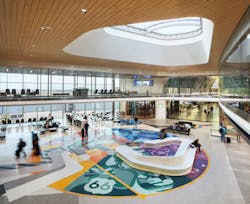Sizing Up Terminal Upgrades
How does an airport, through a building project, create a more pleasant passenger experience? That’s the multi-million-dollar question. While there are some universal challenges and solutions, such as creating new spaces creates new possibilities, no two solutions are exactly the same.
Take a look at a $90 million terminal expansion at Will Rogers World Airport (OKC) and a $245 million concourse modernization at Memphis international Airport in Tennessee (MEM). The OKC expansion opened in September 2021. The modernized MEM concourse opened in February.
The 'World' in Will Rogers World Airport
The $90 million expansion, with four new gates on a new east concourse and an eight-lane consolidated security checkpoint, adds capacity and helps put the “world” in Will Rogers World Airport. Three of the gates are leased to Delta Air Lines and a fourth can accommodate wide-body aircraft. Altogether, the airport now has 24 gates and room to add six more.
When design plans were approved for the concourse in 2015, the airport was seeing more than 3.8 million travelers per year and demand continued to grow.
“Our peak here was in 2019 with 4.4 million passengers,” said Jeff Mulder, Oklahoma City’s director of airports.
A driving issue for the expansion was the need for a larger, consolidated security checkpoint with more pre- and post-security space, Mulder said. The building was updated in the early 2000s, but he said the updates didn’t accommodate post-9/11 security screening procedures for both passengers and baggage.
“So the airport really had been struggling with security lines and not enough space,” he said.
The 151,000 square feet represents the total project. Of that total, the expansion was 133,000 square feet.
“The expansion really expanded the queuing space, the capacity to the checkpoint so that definitely helped the situation that the airport had had for a long time,” Mulder said.
The project also repurposed some existing spaces. For instance, what had been the two screening areas are now large meeter/greeter lobbies.
“The beauty of this project is it was a true extension of what the airport had,” said Mark Timbrook, FSB aviation market principal. HOK and local architect FSB worked with contractor Timberlake Construction and civil engineer of record MacArthur Associated Consultants on the project.
By providing a little bit more space, William Jenkinson, HOK’s regional leader of aviation and transportation, said the expansion provides a little more breathing room, particularly in areas like the gate lounges.
“We’ve all seen it where you walk down the concourse and people are queuing across the concourse and blocking circulation,” he said. “We want to avoid that and provide gate lounges that have the capability for today and for the future to be flexible spaces that can be occupied by people that are multi-tasking at the gate – whether they’re dwelling or working a little bit or grabbing a bite. It’s just a little bit more space to give a little bit more enhanced experience and some flexibility for the future.”
The one gate configured for common use and built with a customs area underneath could be used by any airline and is capable of accommodating an international flight. “The reason why the airport wanted to create this opportunity was twofold,” Jenkinson said. “One is to be able to accommodate a diverted flight from a neighboring airport (due to weather or what have you). The second reason is the authority wants to be ready to be able to provide direct international service, which could be a seasonal service.”
In additional to more breathing room, the expansion design incorporates new technology.
“When we think about ‘modernize’ from the customer experience at an airport,” Jenkinson said, “it’s all about leveraging technology to streamline the process so that traveling becomes a pleasure. There’s no longer long queues at ticketing because everything’s automated. There’s no longer going to be queues at the baggage check because everyone is going to be checking their own bags in the future. A lot of these inconvenient dwell moments on a journey are being slowly removed by technology, which leaves the customer with time to enjoy and time to spend in concessions and retail. Part of the modernization of an airport is to provide facilities which can be enjoyed by the customer of today and the future.”
Materially, the airport authority wanted the airport to offer a world-class experience yet feel like it belonged to the community of Oklahoma City. The refreshed wing sits in harmony with the existing terminal and a contemporary finish, wood ceiling, increased natural daylight, terrazzo flooring is a modern interpretation of the existing building.
The ceiling varies in height reaching up to 12-15 feet. Space in the ceiling and above the checkpoint is used to conceal security infrastructure. Here the ceiling is about 10 feet, Jenkinson said, “then it cascades back up to a larger light-filled volume. You’ll see a little oculus that we put in above ‘the town square.’ That brings natural daylight into the space in addition to all the light from the window in front of you as you go through security.”
Immediately post security is “the town square” with a variety of shops and restaurants, 17 in all, that offer iconic national brands and local favorites.
“As soon as you walk in, it feels like a place you want to be,” Timbrook said. “It’s not like a food court, it’s this light, open, airy space.”
A mosaic in the terrazzo floor and mezzanine glass curtain wall, “OKConnected,” tells the story of Oklahoma City.
“People talk a lot about sense of place but I like to say, ‘How do we make place?’” Jenkinson said. Art is one way, but also in the concession offerings or even pop-up type concessions. “Maybe concessions become seasonal,” he suggested. “Maybe farmer’s markets can exist in the community of the airport.”
Above the town square is a glass-enclosed public observation deck with space for aviation exhibits and views across the airfield and within the terminal. The idea came from then-director Mark Kranenburg, who wanted the people of Oklahoma City to be able to visit the airport, even when they were not traveling.
What “Modern” Means in Memphis
The focus of a $245 million project at MEM was “modernization” of the B Concourse. (The cost estimate includes related projects such as jet bridge construction and electrical upgrades on the A and C concourses.)
With the Delta Air Lines’ removal of passenger transfer hub operations in 2013, airport officials announced preliminary modernization plans in early 2014. Now an origin and destination airport more than a transfer hub, MEM officials deemed modernization necessary to streamline passenger flow, increase space and amenities, and create a more efficient and a “positively MEMorable” travel experience.
With the opening of the newly remodeled B Concourse, gates are no longer spread out over three concourses. The B Concourse consolidates airlines, retail and food and beverage options, and A and C concourses have been decommissioned.
Modernization focused specifically on the spine and the southeast leg of the B Concourse. Twenty-three gates can accommodate 3 million enplanements per year, which would represent a 50 percent increase over current enplanement levels. If passenger growth increases substantially, the southwest leg of the B Concourse could be modernized to add as many as 15 more gates.
Prior to the modernization, Thomas Poulos, senior principal with Thornton Tomasetti, describes the concourse was 60-feet (three 20-foot bays) wide, with columns running down the middle, a narrow hallway, very narrow hold room and very little room for concessions. Thornton Tomasetti provided structural design, façade engineering and sustainability consulting services to Alliiance and local architect UrbanARCH Associates for the project.
Before the airport could widen its corridors, create larger boarding areas with a more open and flexible floor plan and increase its ceiling height, it had to address another sizable challenge.
“People don’t really think about Memphis being a seismically active region,” said Zachary Treece, senior project engineer with Thornton Tomasetti. But, he continued, “This New Madrid Fault in the past has resulted in very large earthquakes, which requires any new structure in the Memphis region, all the way up to St. Louis really, to be designed to withstand high levels of seismic activity on the order of what you would see in Los Angeles.”
The challenge was creating open spaces and plenty of room for concessions and places to relax and do work while waiting for a flight, and at the same time reduce the seismic demand. How did they do it?
“We cut off the top level, the existing roof level and then we spanned over it with long span steel trusses to create a column-free space,” Treece said. “So you go from a 60-foot-wide concourse with columns interrupting your hold rooms and your hallways to a 100-foot-wide concourse with no columns, and it’s very open and very comfortable.”
By removing the upper or roof level, Poulos said, “We reduced the seismic demand of the structure by about 60 percent. This created a very simple one-story structure that could accommodate the new expansion without further remediation. By connecting the new expansion into the remaining structure, we were able to design a new combined structure that meets the new earthquake code."
Passengers might not know what it took to make the concourse seismically sound, but they will notice more natural light through View Smart Windows, a moving walkway, new retail and restaurant options, new artwork and new amenities including a new business center, pet restroom, St. Jude Children’s Research Hospital Patient Lounge, a new military lounge, children’s play area and additional seating areas.
MEM B Concourse Engineering Facts & Figures
- 126 tension rods tie the existing concourse to the new concourse. Each tension rod is pre-tensioned to 50,000 lbs.
- 2,000 tons of structural steel
- 30 roof trusses spanning 100 feet create wider, column-free concourses with ceilings that are 67% higher than before.
- Seismic upgrades made the concourse 15x stronger than before.
- 5-foot-thick mat foundations support the building.
- Anchor rods capable of supporting 220,000 lbs. each are used to anchor the columns into the footings.
Source: Thornton Tomasetti
About the Author
Rebecca Kanable
Assistant Editor
Rebecca Kanable, a veteran journalist, worked with Endeavor Business Media's aviation group from 2021 to 2024 as assistant editor of Airport Business, AMT and Ground Support Worldwide. She previously worked for various publications, including trade magazines and newspapers.

